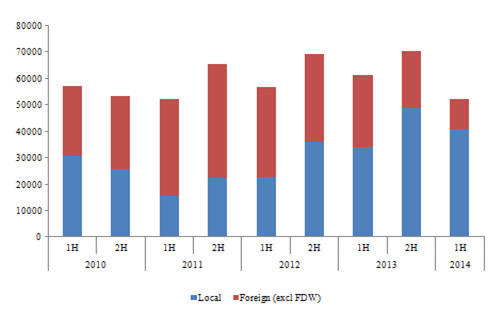Written Answer by Mr Tan Chuan-Jin, Minister for Manpower, to Parliamentary Question on Slowing Down Curbs on Foreign Manpower For Services Sector
Notice Paper No. 291 Of 2014 For The Sitting On 7 Oct 2014
Question No. 104 For Written Answer
MP: Yeo Guat Kwang
To ask the Minister for Manpower:
(a) whether the Ministry will consider slowing down the curbs on foreign manpower for the services sector; and (b) whether targets in managing the growth of foreign manpower in all sectors, except the construction sector, have been achieved.
Answer
- Foreign manpower demand across the Services sector has moderated progressively. In 2013, the foreign workforce (FW) growth in Services sector (excluding foreign domestic workers) was 12,100; compared to 22,800 in 2012 and 53,700 in 2011. The national emphasis on productivity, together with previously announced FW tightening measures, contributed to this moderation.
- In line with the slower growth in foreign workforce, MOM has also moderated our pace of tightening. After tightening measures announced in 2012 and 2013, we did not introduce new FW policy adjustments for the Services sector this year.
- There have been early encouraging results. Incomes of Singaporeans have risen more significantly in 2013 compared to previous years, especially for our low wage workers1. Firms are also responding and adjusting, such as through introduction of technology and automation, offering more self-service options to consumers, or offering better and more flexible job packages to attract Singaporeans.
- For the overall economy, we are approaching our targets in keeping FW growth to sustainable levels. Overall FW growth in 1H 2014 was the lowest since 2009 [Chart 1]. MOM will continue to monitor the situation closely. While the growth in foreign employment has slowed, we expect manpower demand to be firm given the substantial supply of new commercial facilities and infrastructure in the next few years. Domestic-oriented industries within the Services sector – such as food services, retail trade, and accommodation – continued to lag in productivity growth, with significant room for improvement. We intend to maintain our current FW policy stance, without liberalising nor having new measures to tighten foreign worker numbers further, which should maintain the motivation for businesses to adopt manpower-lean business models, and to improve job outcomes for Singaporeans.
Chart 1: Half-yearly employment growth

1 Real income increased by 4.6% (median) and 6.7% (P20) from 2012 to 2013. The real annualised income growth was 1% (median) and 0.1% (P20) for the period 2003 to 2012.